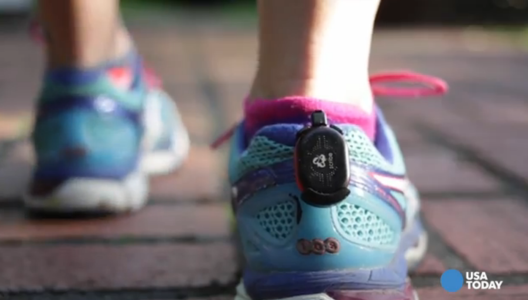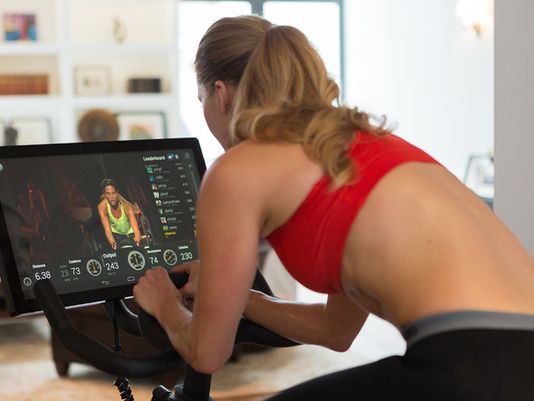
Upgrade your workouts with new fitness tech
When you hear talk of a new fitness gadget these days, it usually has something to do with an exercise band that you wear around your wrist to track steps, calories, and sleep. Those are definitely up there when it comes to the what’s-what of modern tech innovation, but there’s a whole new world of exercise gadgets built to take your workouts to the next level.
Here’s a look at the very best I’ve taken for a ride, run — and used for recovery — so far.

Peloton: Perfect Spin On Stationary Bike
I’m half way through a 45-minute cycling class. I’m pouring sweat. My thighs are screaming. I think for a second that I might actually throw up. “I see you Jenn J. inNorthern California! Keep your cadence up, you’re doing great! Go, go, GOOOOO,” booms class coach Christine M D’Ercole from the Peloton cycling studio in the middle of Manhattan. That is so cool, she just said my name, I think as I crank down a little harder on the Peloton bike I’m riding in the middle of my living room in Oakland, California.
The Peloton Cycle is the most impressive of all the new fitness equipment I’ve tried this year. It’s basically a new spin on the old stationary bike — but unlike the one we ordered from Sears and kept in the basement when I was growing up — the Peloton is attractive, addictive, and seriously whips you into shape. What makes Peloton so special is that you can stream live or on-demand cycling classes right to the 21.5-inch waterproof Android touchscreen tablet that comes attached to the handlebars.
The Peloton experience is light years ahead of when I used to put my road bike on an indoor trainer and ride to cycling DVD’s. That was really loud, tough to do in the early morning hours before my family woke up, and I could also just quit the DVD’s any time I felt like it, no one would ever know. This is really different: In addition to the classes, the bike monitors calories burned, power output, distance traveled, and cadence (pedaling rate) and shows it all to you as you go. There’s a leaderboard where you can see how you compare to riders also taking the class live, from all over the world. If you’re streaming one of the hundreds of recorded classes, you still get to see where you rank against anyone else who has ever taken that class. My best finish so far is low 20’s out of about 80 people. But I’m getting stronger and faster everyday. I’ll get top 20, I feel it. And that alone motivates me in a way home exercise equipment never has before.
So, what’s the catch? The Peloton bike costs a small fortune. The bike and waterproof monitor are $1,995. You also need shoes that clip in and you’ll want a set of hand weights to go along with that part of many of the classes. And, there’s a $39-a-month subscription to stream the classes, with a one-year commitment. I think of it as fitness gear for the 1% — but people are snatching them up faster than Peloton can make them. In fact, the company just announced that it raised $30 million in new financing to expand brick-and-mortar retail locations and accelerate bike production. (Now if there was just some sort of angel funding for those of us who want buy one!) In any case, it finally feels like the future of home exercise equipment is here, and I can’t wait to see something like this for treadmills or ellipticals too.
runScribe: Miles Ahead of Other Trackers
According to the latest studies, an estimated 55 million people in the U.S. run or jog regularly. Out of those, nearly 70 percent will suffer a running related injury. That’s a lot of bum-knee’s, hurt feet, and sore-shins — and a new $149 wearable tracker calledrunScribe wants to help. The runScribe is a silver-dollar sized sensor that attaches to your shoe and gives you an unprecedented 3D view of how you run.
Every time you take a step, the runScribe captures 13 different data points to help analyze your form. Does your heel jam into the pavement with every stride or do your toes take the brunt of the force? Does your foot roll outward (pronate) or inward, (supinate)? It also tracks your pace, stride rate, stride length, runtimes, distance, and speed. The information is analyzed in the runScribe app, and displayed on a dashboard with helpful tips.
This data is actually really important to serious runners and weekend warriors alike. It can help alleviate current aches and pains, as well as prevent future injuries by narrowing down some of the biggest causes specifically related to you. I’ve already used it to help with my foot pain, knees, hips, and even lower back discomfort. It’s a great tool for all runners from casual to pro.
If workout recovery isn’t part of your exercise routine already, just wait till you’re my age! There comes a point when stretching and caring for hard-worked muscles becomes almost as important as working them out in the first place. Unless you can afford a personal masseuse at the end of every workout, a foam roll is often your best way to go.
Foam rollers are an inexpensive, super-versatile piece of equipment — great for releasing tension, working out knots, and rehabbing tired and sore muscles with the help of some extra pressure. The Hyperice Vyper ($199) is a super high-tech leap up from your no-tech foam roll. In fact, in the battle against injury, if a foam roller is a sword, the Vyper is a light saber.
It’s a deeply ridged and very firm foam roller with a lithium ion powered vibrating mechanism at its core. Touch the button on the end and it actually vibrates on three different settings, each one getting more intense. Fair warning: think less shake and more earthquake. It’s intense, but I’ve honestly never hurt so good. This heavy-duty brain-rattling bit of magic helps increase circulation and loosen up tight muscles.
Okay, these are the best of the three categories that I’ve tested extensively so far this year — but there are a lot of other new great fitness gadgets in all price ranges and for all levels. I’ll have more on these in upcoming episodes and columns, so be sure to check back every weekend. In the meantime, what high tech equipment are you using to take your workouts to the level? Be sure to share in the comments section.
Tags: fitness, fitness gadgets, foam roller, HyperIce Vyper, Peloton Bike, running, runScribe, stationary bike, wearablePosted in Health & Fitness, TechNow, Uncategorized


PP Pipes : Polypropylene pipes are chemical-resistant and used in industrial applications. ElitePipe Factory in Iraq ensures top-quality PP pipes for industrial needs.